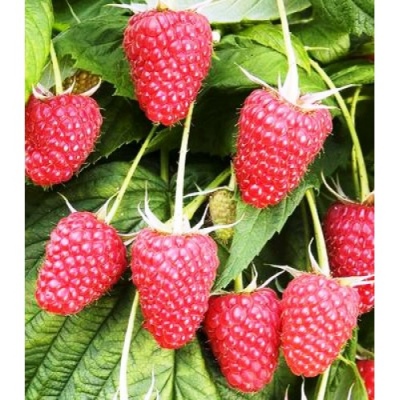
- Authors: V.V. Kichina, Russia
- Repairability: No
- Berry color: deep ruby
- Taste: sweet and sour
- Ripening period: early
- Berry weight, g: 7-11
- Yield: 4-9 kg per bush
- Frost resistance: medium
- Appointment: dessert, table
- Fruiting period: from 5-7 July to October
Raspberry bushes are popular nowadays. The Ruby Giant variety became famous for its large berries. Such plants are unpretentious in care and show high yield rates.
Breeding history of the variety
Raspberry variety Ruby Giant bred at the Moscow Institute of Horticulture. This variety is considered new, its progenitor is the Patricia raspberry. Ruby Giant took the best quality indicators from the original variety, therefore it is often called the improved Patricia.
Description of the variety
This raspberry variety is a perennial plant with a one-year development cycle. This term refers to the ripening of berries on the branches that have grown this year. In ordinary garden raspberries, berries appear only on shoots that are 2 years old. The possibility of growing raspberries on the shoots of the first year significantly complicates the process of caring for plants. Pruning becomes more difficult as it needs to be treated very carefully. The Ruby Giant variety is cut in the autumn directly under the root. However, experienced gardeners have proven that pruning should be done like garden raspberries to get an early harvest of this raspberry variety. This principle is also valid for this variety, allowing a two-time harvest, despite the fact that the raspberry is not repaired. The first time the crop is harvested on young shoots of the current year, and the second ripens on late or annual ones.
Ripening terms
The Raspberry Ruby Giant ripens between July and September. The fruiting period is average.
Yield
The plant has a high yield, which can be achieved by properly pruning the plants. On average, more than 2 kg can be harvested from one bush, and for the entire ripening period this figure reaches 9 kg. Such a yield indicator justifies the labor invested in growing this plant. Raspberries of this variety can be eaten fresh, processed and frozen.
Berries and their taste
The berries are large in size, their weight can reach 11 g. The shape of a truncated cone and small drupes make the berries dense and elastic, which makes it possible to transfer transportation well over long distances.
The berries have a bright red or ruby hue. Unlike regular garden raspberries, Ruby Giant has a sour taste that makes it fresh and spicy.

Growing features
Cultivation of this variety is recommended in open sunny areas, where there is no wind and draft. In soils, the plant is unpretentious. A rich harvest will be achieved on loose loam that is capable of retaining moisture.
Site selection and soil preparation
Having chosen a sunny place for planting a plant, in a couple of weeks preparatory planting activities are carried out and grooves for planting are prepared.Mixed humus, peat, ash with superphosphate and turf soil are introduced as a nutrient substrate for 1/3 of the planting pit. The seedling is placed on a mound formed in a hole. It is very important to evenly distribute the roots, after which they are carefully covered with earth to the root collar, excluding the leaving of an air cavity. After planting, each bush must be thoroughly watered and mulched with peat.
Planting is carried out at a distance of 1.5 m between the bushes. The same distance should be kept between the rows.


Pruning
Raspberry variety Ruby Giant is pruned according to the principle of ordinary garden raspberries. This allows you to increase its fruiting period, since the first crop is tied on last year's shoots, and the second on young plants.

Watering and feeding
Raspberry seedlings require careful watering, soil impregnation should be carried out to a depth of 40 cm. Particular attention is paid to watering during flowering and fruit setting. Moisturizing activities are stopped immediately before harvesting. And also carry out abundant watering before preparing the raspberry tree for winter.
Top dressing must be applied at least 3 times per season. The first time raspberries are fed with nitrogen fertilizers in the spring, and the second time is when the plants bear fruit. A phosphorus-potassium composition is required here. To support the root system of the plant during the wintering period, complex mixtures are introduced in the fall.
The lack of nutrients will affect the crushing of berries, yellowing and drying of the leaves.




Unfortunately, raspberries, like other plants, do not bypass various diseases and pests. Only armed with the knowledge and the necessary means for this, you can cope with such troubles.To help the plant, it is very important to be able to recognize the disease in time and begin timely treatment.
Reproduction
The variety is characterized by a small amount of root formation, therefore propagation is carried out using cuttings and green shoots. According to statistics, cuttings take root worse than propagation through overgrowths. However, cuttings can be prepared in large quantities.
Raspberry Ruby Giant is very popular among gardeners. Despite the presence of sourness in the taste of berries, raspberries have natural flavor characteristics, as they resemble the true raspberry flavor without sweeteners. The plant is unpretentious in care and is able to please the owners of the site with a magnificent harvest throughout the summer season.








































































